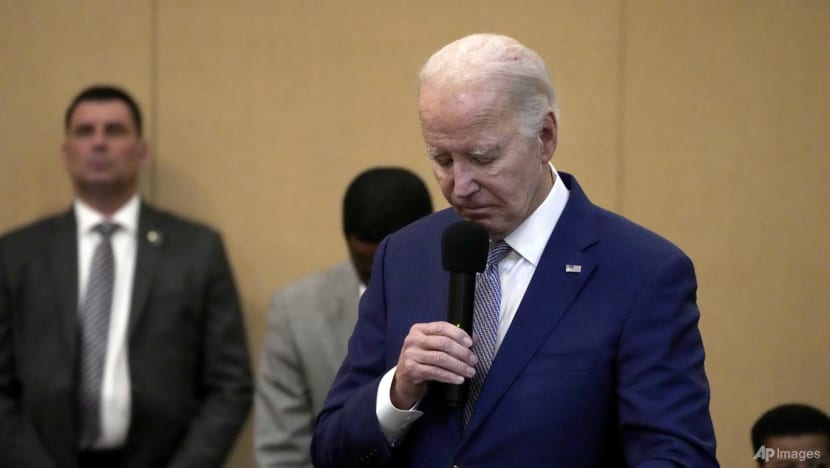Commentary: After a fatal strike, restraint becomes a challenging option for the US
Three months since it bulked up its military presence in the Middle East, Washington has failed to prevent attacks against its soldiers, says Jean-Loup Samaan, senior research fellow at the Middle East Institute, NUS.

US President Joe Biden bows his head in a moment of silence for the three American troops killed on Jan 28, 2024, in a drone strike in northeast Jordan. (Photo: AP/Jacquelyn Martin)

This audio is generated by an AI tool.
SINGAPORE: President Joe Biden said on Tuesday (Jan 30) that he has decided how the United States will respond to a drone strike that killed three American troops and wounded at least 34 others in Jordan at the weekend.
The White House has kept details under wraps for obvious security reasons, but National Security Council spokesman John Kirby has indicated that the response will be “tiered” and involve “potentially multiple actions”.
Mr Biden, on his part, has insisted he does not want a wider war in the Middle East.
Sunday’s attack on the Tower 22 US base in Jordan, which reportedly struck near the troops’ sleeping quarters, is the first deaths of American troops by enemy fire since the Israel-Hamas war began. Though the perpetrators remain unknown, a spokesperson for the Pentagon said the attack "has the footprints of Kata'ib Hezbollah" - an Iran-backed Iraqi armed group with ancillary operations in Syria.
DEATHS TRAGIC, BUT PREDICTABLE
Since the Israel-Hamas war began, more than 160 attacks have been launched by militias against the US across the Middle East. More than 120 US service members have already been injured, and two Navy Seals lost their lives in the Arabian Sea during a raid on a ship carrying Iranian missile components.
Given this context, the deaths of three American soldiers were a tragic, but predictable, event. As one US official told CNN, "it is the same type of attack they've done 163 times before, and on 164, they got lucky".
As it turned out, a freak event contributed to the attack’s success - anti-drone defences were turned off at the moment the base was struck, as a US drone was returning at the same time.
Now, the Biden administration faces a painful reality check: Three months since it bulked up its military presence in the Middle East, Washington has failed to prevent attacks against its soldiers.
Last October, the White House ordered the deployment of two carrier strike groups to the Mediterranean. Additionally, 2,000 US soldiers were put on “24-hour prepare-to-deploy” orders. At the time, when asked by CBS News if Iran and Hezbollah would be tempted to escalate, Mr Biden had a simple message for Tehran: "Don't, don't, don't".
Despite that impressive demonstration of force, Iran-backed militias have repeatedly tested US resolve in Syria, Iraq, and Yemen.
In the Red Sea, Washington’s warnings to the Houthi militants not to attack commercial shipping have fallen on deaf ears. In December, a multinational coalition, Operation Prosperity Guardian, was set up to secure the vital seaway and intercept Houthi strikes. This was followed by strikes against Houthi positions in Yemen earlier this month, which failed to dissuade the insurgent group. Not only did the US-led air strikes fail to degrade the Houthi firepower, but they were also immediately followed by new retaliatory missile and drone attacks at sea.
These attacks highlight the erosion of US credibility against its enemies in the Middle East.
CAUGHT BETWEEN ROCK AND A HARD PLACE
Unfortunately, there are no good options for the US. A proportional response that strictly targets the assets and the individuals behind the latest attack may be the most cautious way to retaliate without provoking a war with Iran. Arguably, though fatalities constitute a human tragedy for Washington, its vital interests remain intact, so the response should be crafted accordingly.
However, that logic also sends the wrong message: Just like the air strikes against Houthis earlier, a limited military response may fail to deter future attacks. Instead, it may only remind everyone that ultimately, Washington wants to avoid a regional war at all costs. This might be read as evidence of indecisiveness.
Like Mr Biden, Mr Kirby told US media after the latest attack that "we don't seek a war with Iran". This could be interpreted as a demonstration of American reluctance to confront Tehran.
In a similar vein, both Kata’ib Hezbollah and Iran have backed off too. Following the attack, Iran immediately distanced itself, stating that it has “no involvement in the decision-making of resistance groups”. On Tuesday, Kata’ib Hezbollah announced it was suspending its attacks on US forces in the region to avoid “embarrassment” to the Iraqi government.
RISKS IN GOING AFTER IRAN
The other US option is to go after the main sponsor behind the militias - Iran. While Tehran has denied any involvement in the Jordan attack and others, none of its proxies in Syria, Iraq or Yemen would be able to attack the US without the military support provided by the Islamic Revolutionary Guard Corps.
Some have said that going after Iran might be a way to reassert US deterrence and force Tehran to curb its support to its proxies. This was the logic behind the US killing of Iranian General Qassem Soleimani in 2020, after repeated attacks against US troops in Iraq: It showed Tehran that Washington had no problem with playing a game of chicken.
This option is, of course, risky. Iran has already stated that an attack against its regime would be deemed a "red line". Such a move might precipitate the regional war the White House has tried hard to prevent. But over the longer term, those calling for stronger action say forgoing this option carries an arguably higher cost. Tolerating a repeat of the hundreds of attacks thus far without inflicting severe punishment erodes US credibility and may not even prevent a broader war.
Complicating matters is the fact that US domestic politics will come into play. Less than a year before he faces a difficult re-election campaign, Mr Biden will be wary of looking weak in relation to his presumptive challenger, Donald Trump, and Republican anti-Iran hawks.
Mr Biden will surely want to avoid the fate of Jimmy Carter, the Democrat president whose re-election campaign in 1980 was derailed because of a crisis also sparked by the Iranian regime.
When push comes to shove, the US administration will most likely go for an option halfway between the two exposed here. It will aim to "escalate to de-escalate", in order to send strong messages, both at home and in Tehran.
What happens next remains uncertain, but it is worth considering if the White House should reconsider its stance of restraint.
Jean-Loup Samaan is a senior research fellow at the Middle East Institute of the National University of Singapore.















